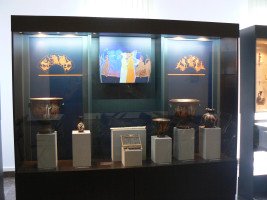EXHIBITION "AT THE DAWN OF CIVILIZATION"
(prehistoric cultures in the region of Nessebar)
|
|
The exhibition presents prehistoric artifacts from Ancient Nessebar Museum’s collection, excavated from tells (settlement mounds) situated in the area around Nessebar, and mostly along the fertile valley of the Hadzhiiska River. Most numerous are the artifact from the so-called “Goat’s mound”, near the town of Kableshkovo, which is the only tell in the region that has been thoroughly studied.
The prehistoric Goat’s mound consists of cultural layers dated to the Copper Age (Chalcolithic period) and the Bronze Age. The pottery excavated from the Early Chalcolithic layer provides insight into the distinctiveness of the culture that inhabited the southern portion of the Western Black Sea cost, during that remote period. This culture had a specific character that differed from the contemporary cultures in Thrace and along the north part of the Western Black Sea coast, although it does comprise elements of these cultures (Maritsa, Sava and Hamangia cultures).
On the Late Chalcolithic level of the tell two kilns for firing of pottery were found, one of them inside a large building dug into the ground. Both of them contained whole and unfinished vessels and along with the many tools discovered around they testify to the main occupation of the residents of the settlement - production of pottery. Besides the large amount of ceramic vessels and tools for their making, stone, flint and copper tools were also excavated, as well as various anthropomorphic and zoomorphic figurines and ornaments.
The oldest necropolis discovered so far south of the Balkan Mountains was found near the Goat’s mound, dating to the Late Copper Age and the Bronze Age (second half of the 5th millennium BC).
The prehistoric artifacts displayed in the exhibition present the Chalcolithic culture of the Black Sea region of Thrace. During that distant period, in Thrace and the Lower Danube region, metallurgy of copper and processing of gold was developed for the first time in the world. The region gave rise to a Copper Age civilization that had a great influence on later cultures in Europe and the Near East.
|
EXHIBITION “NESSEBAR AND THE BAY ON OLD MAPS (4TH – 19TH CENTURY)”
|
|
The exhibition is displayed inside Christ Pantokrator church in the Old Nessebar. It is realized by Ancient Nessebar Museum with the support of International Commercial and Cultural Centre GEOPAN and the use of “Thrace” digital archives. The artistic arrangement is designed by painter Georgi Gyonev.
Eighteen maps are on display, dating from the 4th to the 19th century, illustrating a lasting interest in Southeast Europe and in particular the Black Sea coast and Nessebar. The maps are from different cartographical branches: road, sea, continental, historical, commercial, etc.
The exhibition will be open for visitors every day untill the end of October. It will be yet another site where Nessebar’s visitors, both Bulgarian and international, can find out more about the role that ancient Mesambria and medieval Nessebar played as a big commercial port and a centre of overseas trade. The 14th century church which is hosting the exhibition is in itself one of the main sites in the Old town, so you will be able to also enjoy a true masterpiece of medieval religious architecture.
|
AN EXHIBITION “MUSIC, DANCE AND THEATRE IN ANTIQUITY”
|
|
The exhibition, titled “Music, dance and theatre in Antiquity”, is arranged in Hall 1 of the Archaeological museum of Nessebar.
The exhibition is a result of collaboration between Ancient Nessebar Museum and the Archaeological Museum of Sozopol.
Both of the museums have selected intriguing artifacts demonstrating the magnificence of ancient art, most of which discovered in recent years during archaeological excavations at the necropolises of both towns. The most interesting red-figure vessels from the rich collection of the Archaeological museum of Sozopol are displayed – 2 craters dated to the early 4th century BC, decorated with scenes of dancing young men and women, and a calyx-crater with a depiction of a girl playing a hand drum. Of exceptional value is an oenochoe from the 5th century BC with images of the Muses, the goddesses of the arts, painted by the famous Eretria Painter. Provided by the museum in Sozopol, specially for the exhibition in Nessebar, are also several terracotta figurines, among which, two female acrobats stand out, as well as the only discovered in Bulgaria so far double flute made of bones, dated to the 5th century BC.
The Ancient Nessebar Museum also presents itself with some unique artifacts, including a bronze panflute (syrinx) discovered a couple of years ago at the town’s necropolis, a number of exquisite terracotta statuettes, female protomes, the famous embossed “Megara cups” (2nd c. BC), etc.


|
|


